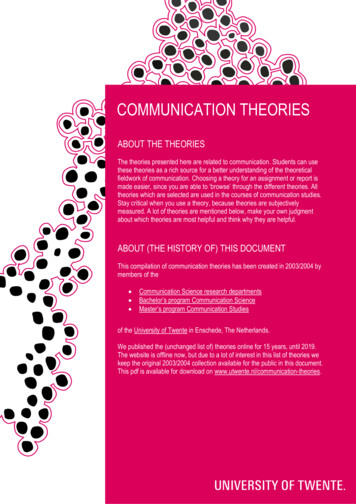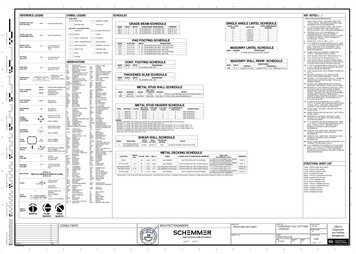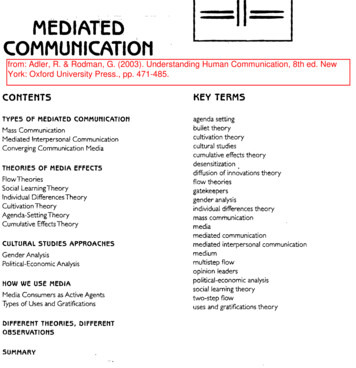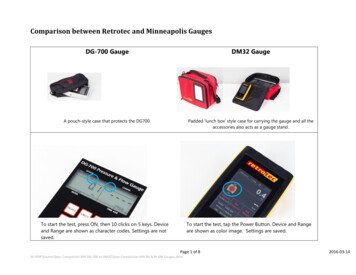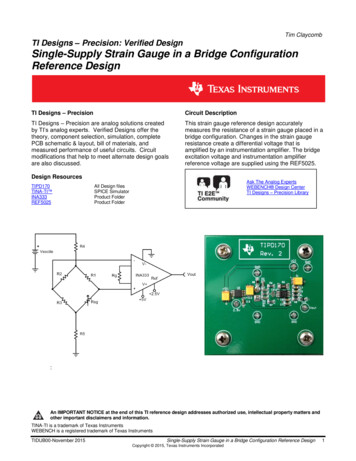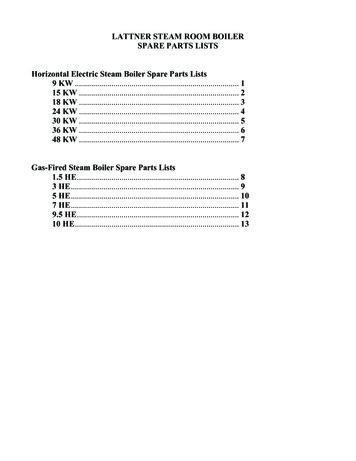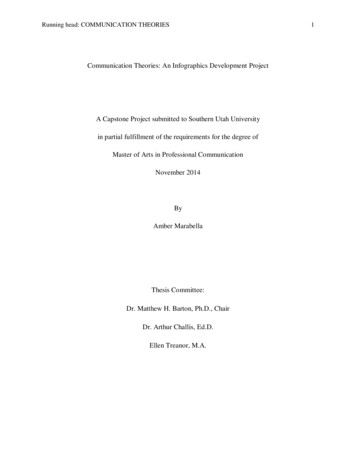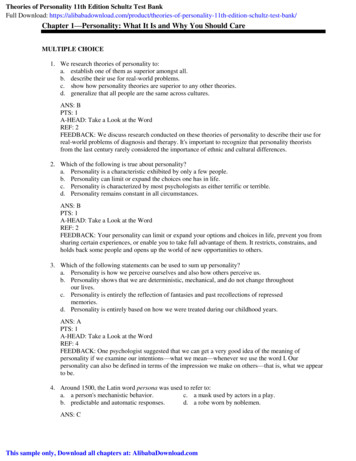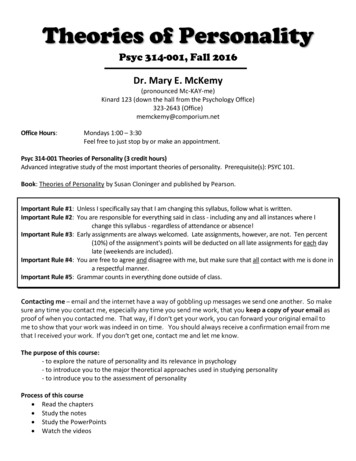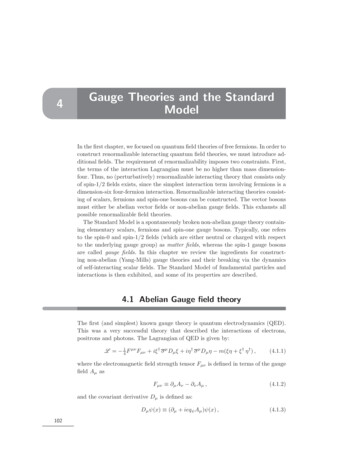
Transcription
4Gauge Theories and the StandardModelIn the first chapter, we focused on quantum field theories of free fermions. In order toconstruct renormalizable interacting quantum field theories, we must introduce additional fields. The requirement of renormalizability imposes two constraints. First,the terms of the interaction Lagrangian must be no higher than mass dimensionfour. Thus, no (perturbatively) renormalizable interacting theory that consists onlyof spin-1/2 fields exists, since the simplest interaction term involving fermions is adimension-six four-fermion interaction. Renormalizable interacting theories consisting of scalars, fermions and spin-one bosons can be constructed. The vector bosonsmust either be abelian vector fields or non-abelian gauge fields. This exhausts allpossible renormalizable field theories.The Standard Model is a spontaneously broken non-abelian gauge theory containing elementary scalars, fermions and spin-one gauge bosons. Typically, one refersto the spin-0 and spin-1/2 fields (which are either neutral or charged with respectto the underlying gauge group) as matter fields, whereas the spin-1 gauge bosonsare called gauge fields. In this chapter we review the ingredients for constructing non-abelian (Yang-Mills) gauge theories and their breaking via the dynamicsof self-interacting scalar fields. The Standard Model of fundamental particles andinteractions is then exhibited, and some of its properties are described.4.1 Abelian Gauge field theoryThe first (and simplest) known gauge theory is quantum electrodynamics (QED).This was a very successful theory that described the interactions of electrons,positrons and photons. The Lagrangian of QED is given by:L 14 F µν Fµν iξ † σ µ Dµ ξ iη † σ µ Dµ η m(ξη ξ † η † ) ,(4.1.1)where the electromagnetic field strength tensor Fµν is defined in terms of the gaugefield Aµ asFµν µ Aν ν Aµ ,(4.1.2)and the covariant derivative Dµ is defined as:Dµ ψ(x) ( µ ieqψ Aµ )ψ(x) ,102(4.1.3)
Non-abelian gauge groups and their Lie algebras103where ψ(x) ξ(x) or η(x) with qξ 1 and qη 1. Note that we have writteneq. (4.1.1) in terms of the two-component charged fermion fields ξ and η. Theidentification of these fields with the electron and positron (with correspondingelectric charges qψ in units of e 0) has been given in Section E.1The QED Lagrangian consists of a sum of the kinetic energy term for the gauge(photon) field, 41 Fµν F µν and the Dirac Lagrangian with the ordinary derivative µ replaced by a covariant derivative Dµ . This Lagrangian is invariant under a localU(1) gauge transformation:Aµ (x) Aµ (x) µ Λ(x) ,ξ(x) exp[ieΛ(x)]ξ(x) ,η(x) exp[ ieΛ(x)]η(x) .(4.1.4)(4.1.5)(4.1.6)The Feynman rule for electrons interacting with photons is obtained by takingGψ eqψ for ψ ξ and η in eq. (2.6.1). That is, we employ Gξ Gη e inthe two-component Feynamn rules displayed in Fig. 2.6. One can easily check thatthe corresponding four-component Feynman rule of Fig. 3.1 yields the well-knownrule for the e e γ vertex of QED.One can extend the theory above by including charged scalars among the possiblematter fields. For example, a complex scalar field Φ(x) of definite U(1) charge qΦwill transform under the local U(1) gauge transformation:Φ(x) exp[ ieqΦ Λ(x)]Φ(x) .(4.1.7)A gauge invariant Lagrangian involving the scalar fields can be obtained from thefree-field scalar Lagrangian of eq. (3.0.3), by replacing µ Φ(x) with Dµ Φ(x) ( µ ieqΦ )Φ(x). One may also add gauge-invariant Yukawa interactions of theformLY yijk Φi ψj ψk h.c. ,(4.1.8)where Φi consist of either neutral or charged scalar fields and ψi consist of neutralMajorana (χ) or charged Dirac pairs (ξ and η) of two-component fermion fields. The(complex) Yukawa couplings yijk vanish unless the condition qΦi qψj qψk 0 issatisfied, as required by gauge invariance.4.2 Non-abelian gauge groups and their Lie algebrasAbelian gauge field theory can be generalized by replacing the abelian U(1) gaugegroup of QED with a non-abelian gauge group G. We again consider possible matterfields—multiplets of scalar fields Φi (x) and two-component fermion fields ψi (x) [or1It is a simple matter to rewrite eq. (4.1.1) in terms of the four-component spinor electron field.Simply replace µ Ψ(x) with Dµ Ψ(x) in the Dirac Lagrangian [eq. (3.2.60)] with qΨ 1 andadd the kinetic energy term for the gauge fields.
Gauge Theories and the Standard Model104equivalently, four component fermions Ψi (x)] that are either neutral or chargedwith respect to G.The symmetry group G can be expressed in general as a direct product of a finitenumber of simple compact Lie groups and U(1). A direct product of simple Liegroups [i.e., with no U(1) factors] is called a semi-simple Lie group. The list of allpossible simple Lie groups are known and consist of SU(n), SO(n), Sp(n) and fiveexceptional groups (G2 , F4 , E6 , E7 and E8 ). Given some matter field (either scalaror fermion), which we generically designate by φi (x), the gauge transformationunder which the Lagrangian is invariant, is given by:φi (x) Ui j (g)φj (x) ,i, j 1, 2, . . . , d(R) ,(4.2.1)where g is an element of G (that is, g is a specific gauge transformation) and U (g)is a (possibly reducible) d(R)-dimensional unitary representation R of the group G.One is always free to redefine the fields via φ(x) V φ(x), where V is any fixedunitary matrix (independent of the choice of g). The gauge transformation law forthe redefined φ(x) now has U (g) replaced by V 1 U (g)V . If U (g) is a reduciblerepresentation, then it is possible to find a V such that the U (g) for all groupelements g assume a block diagonal form. Otherwise, the representation U (g) isirredicible. The matter fields of the gauge theory generally form a reducible representation, which can subsequently be decomposed into their irreducible pieces.Irreducible representations imply that the corresponding multiplets transform onlyamong themselves, and thus we can focus on these pieces separately without lossof generality.The local gauge transformation U (g) is also a function of space-time position, xµ .Explicitly, any group element that is continuously connected to the identity takesthe following form:U (g(x)) exp[ iga Λa (x)T a ] ,(4.2.2)where there is an implicit sum over the repeated index a 1, 2, . . . , dG . The T aare a set of dG linearly independent hermitian matrices2 called generators of theLie group, and the corresponding Λa (x) are arbitrary x-dependent functions. Theconstants ga (which is analogous to e of the abelian theory) are called the gaugecouplings. There is a separate coupling ga for each simple group or U(1) factor ofthe gauge group G. Thus, the generators T a separate out into distinct classes, eachof which is associated with a simple group or one of the U(1) factors contained inthe direct product that defines G. In particular, ga gb if T a and T b are in thesame class. If G is simple, then ga g for all a.Lie group theory teaches us that the number of linearly independent generators,dG , depends only on the abstract definition of G (and not on the choice of representation). Thus, dG is also called the dimension of the Lie group G. Moreover, the2The condition of linear independence means that ca T a 0 (implicit sum over a) implies thatca 0 for all a.
Non-abelian gauge groups and their Lie algebras105commutator of two generators is a linear combination of generators:[T a , T b ] if abc T c ,(4.2.3)where the f abc are called the structure constants of the Lie group. In studying thestucture of gauge field theories, nearly all the information of interest can be ascertained by focusing on infinitesimal gauge transformations. In a given representationR, one can expand about the d(R) d(R) identity matrix any matrix representationof a group element U (g(x)) that is continuously connected to the identity element:U (g(x)) Id(R) iga Λa (x)T a ,(4.2.4)where the T a comprise a d(R)-dimensional representation of the Lie group generators. Then, the infinitesimal gauge transformation corresponding to eq. (4.2.1) isgiven by φi (x) φi (x) δφi (x), whereδφi (x) iga Λa (x)(T a )i j φj (x) .(4.2.5)From the generators T a , one can reconstruct the group elements U (g(x)), so it issufficient to focus on the infinitesimal group transformations. The group generatorsT a span a real vector space, whose general element is ca T a , where the ca are realnumbers.3 One can formally define a “vector product” of any two elements of thevector space as the commutator of the two vectors. For example, using eq. (4.2.3),it is clear that the vector product of any two vectors [ca T a , db T b ] is a real linearcombination of the generators, which is also an element of the vector space. Consequently, this vector space is also an algebra, called a Lie algebra. Henceforth, theLie algebra corresponding to the Lie group G will be designated by g. A Lie algebrahas one additional important property: a T , [T b , T c ] T b , [T c , T a ] T c , [T a , T b ] 0 .(4.2.6)This is called the Jacobi identity, and it is clearly satisfied by any three elementsof the Lie algebra.If the symmetry group G is a direct product of simple Lie group and U(1) factors,then its Lie algebra g is a direct sum of a finite number of simple Lie algebras andu(1).4 A direct sum of simple Lie algebras [i.e., with no u(1) factors] is called a semisimple Lie algebra. If T a and T b belong to different classes (i.e., different factors ofthe direct sum), then [T a , T b ] 0. Equivalently, f abc 0 if T a , T b and T c do notall belong to the same class.In the next section, we will see that the gauge fields transform under the adjointrepresentation of the (global) gauge group. The explicit matrix elements of the34With the T a hermitian, we require the ca to be real in order that U (g) be unitary. Then, theT a span a real Lie algebra. Mathematicians consider the elements of the real Lie algebra to beica T a , with anti-hermitian generators iT a . Note that for real Lie algebras, the representationmatrices for T a (or iT a ) may be complex or quaternionic.The Lie algebra u(1) is equivalent to the vector space of real numbers. The vector product isthe commuatator, which vanishes for any pair of u(1) elements. Thus, u(1) is an abelian Liealgebra.
Gauge Theories and the Standard Model106adjoint representation generators are given by(T a )bc ifabca, b, c 1, 2, . . . , dG .(4.2.7)Thus, the dimension of the adjoint representation matrices coincides with the number of generators, dG . Hence, we shall often refer to the indices a, b, c as adjointindices. For real Lie algebras, the fabc are real numbers. Note that fabc facb[as a consequence of eq. (4.2.3)], so that in the adjoint representation the iT a arereal antisymmetric matrices. The representation matrices of the corresponding Liegroup elements [eq. (4.2.2)] are therefore real and orthogonal. Thus, the adjointrepresentation provides a real representation of the Lie group and Lie algebra.The choice of basis vectors (or generators) T a is arbitrary. Moreover, the valuesof the structure constants f abc also depend on this choice of basis. Nevertheless,there is a canonical choice which we now adopt. The generators are chosen suchthat:Tr(T a T b ) TR δ ab ,(4.2.8)where TR depends on the irreducible representation of the T a . Having chosen thisbasis, there is no distinction between upper and lower adjoint indices.5 Moreover,in this basis the f abc are completely antisymmetric under the interchange of a, band c.6 One can show that once TR is chosen for any one non-trivial irreduciblerepresentation R, then the value of TR for any other irreducible representation isfixed. Corresponding to each simple real (compact) Lie algebra, one can identifyone particular irreducible representation, called the defining representation (sometimes, but less accurately, called the fundamental representation); the most usefulexamples are listed in Table 4.1. For the defining (or fundamental) representation(which is indicated by R F ), the conventional value for TR is taken to be:TF 12.(4.2.9)As noted above, the basis choice of eq. (4.2.8) with the normalization conventiongiven by eq. (4.2.9) determines the value of TR for an arbitrary irreducible representation R. The quantity TR /TF is called the index of the representation R.For the record, we mention two other properties of Lie algebras that will beuseful in this book. First, given any semi-simple Lie algebra g and a correspondingirreducible representation of anti-hermitian generators iT a , one can always find anequivalent representation V 1 T a V for some unitary matrix V . There exists somechoice of V (not necessarily unique) that maximizes the number of simultaneousdiagonal generators, V 1 T a V . This maximal number rG , called the rank of g, isindependent of the choice of representation, and is a property of the abstract Liealgebra. The ranks of the classical Lie algebras are given in Table 4.1.Second, a Casimir operator is defined to be an operator that commutes with56More generally, in an arbitrary basis, Tr(T a T b ) TR g ab , where g ab is the Cartan-Killing form(which can be used to raise and lower adjoint indices).By definition, f abc is antisymmetric under the interchange of a and b. But the complete antisymmetry under the interchange of all three indices requires eq. (4.2.8) to be satisfied.
Non-abelian gauge field theory107Table 4.1 Simple real compact Lie algebras, g, of dimension dG and rank rG .Note that [ 12 n] indicates the greatest integer less than 21 n. The definingrepresentation refers to arbitrary linear combinations ica T a , where the ca arereal and the T a are the generators of G.gso(n)dG1n(n22 1)rGdefining representation for iT a[ 12 n]n n real antisymmetricsu(n)n 1n 1n n traceless complex anti-hermtiansp(n)n(2n 1)nn n quaternionic anti-hermitianall the generators T a of G. One can prove that a simple Lie algebra of rank rGpossesses rG independent Casimir operators. The most important of these is thequadratic Casimir operator, which is defined by:(T 2 )i j (T a )i k (T a )k j CR δi j .(4.2.10)Any operator that commutes with all the generators must be a multiple of theidentity (by Schur’s lemma). The coefficient of δi j depends on the representation Rand is denoted by CR . By multiplying eq. (4.2.10) by δj i , one derives an importanttheorem:TR dG CR d(R) ,(4.2.11)where d(R) is the dimension of the representation R. Note that for the adjointrepresentation (R A), d(A) dG , so that CA TA . As an example, for SU(n),Table 4.1 yields dG n2 1 and d(F ) n. Using eq. (4.2.9), one the obtainsCF (n2 1)/(2n). From an explicit representation of the f abc for SU(n), one canalso derive CA TA n.4.3 Non-abelian gauge field theoryIn order to construct a non-abelian gauge theory, we follow the recipe presented inthe case of the abelian gauge theory. Namely, we introduce a gauge field Aµ and acovariant derivative Dµ . By replacing µ with Dµ in the kinetic energy terms of thematter fields and introducing an appropriate transformation law for Aµ , the resulting matter kinetic energy terms are invariant under local gauge transformations.As an example, consider a scalar field theory with the LagrangianL ( µ Φi )† ( µ Φi ) V (Φ, Φ† ) ,(4.3.1)where the scalar potential V is invariant under gauge transformations, Φi (x)
Gauge Theories and the Standard Model108Ui j (g)Φj (x); that is,V (U Φ, (U Φ)† ) V (Φ, Φ† ) .(4.3.2)Although L is invariant under global gauge transformations, the kinetic energyterm is not invariant under local gauge transformations due to the presence ofthe derivative. In particular, under local gauge transformations µ Φ µ (U Φ) U µ Φ ( µ U )Φ. We therefore introduce the covariant derivative acting on a matterfield that transforms according to some representation R of the symmetry groupG:(Dµ )i j δi j µ iga Aaµ (x)(T a )i j ,a 1, 2, . . . , dG ,(4.3.3)where the flavor indices i, j 1, 2, . . . , d(R). If the symmetry group is simple, thenga g. Otherwise ga gb if and only if T a and T b belong to the same simple Liealgebra [or u(1) factor] in the direct sum decomposition of the Lie algebra g.By introducing a suitable transformation law for Aaµ (x), one can arrange Dµ Φ totransform under a local gauge transformation asDµ Φ U Dµ Φ ,(4.3.4)L (Dµ Φi )† (Dµ Φi ) V (Φ, Φ† )(4.3.5)in which case,is invariant under local gauge transformations.The transformation law for Aaµ (x) is most easily expressed for the matrix-valuedgauge field7Aµ (x) ga Aaµ (x)T a .(4.3.6)Under local gauge transformations, the matrix-valued gauge field transforms asAµ U Aµ U 1 iU ( µ U 1 ) .Using eq. (4.3.7), one quickly shows that Dµ Φ transforms as expected: Dµ Φ ( µ iAµ )Φ µ iU Aµ U 1 U ( µ U 1 ) U Φ U Dµ Φ µ U U ( µ U 1 )U Φ U Dµ Φ .(4.3.7)(4.3.8)In the last step, we noted that µ U U ( µ U 1 )U ( µ U )U 1 U ( µ U 1 ) U µ (U U 1 ) U 0 ,(4.3.9)(4.3.10)since U U 1 I.It is also useful to exhibit the infinitesimal version of the transformation law, by7The matrix-valued gauge field that one employs in the covariant derivative depends on therepresentation of the matter fields on which the covariant derivative acts.
Non-abelian gauge field theory109taking the infinitesimal form for U [eq. (4.2.4)]. This allows us to directly writedown the transformation law Aaµ (x) Aaµ (x) δAaµ (x), whereδAaµ ga f abc Λb Acµ µ Λa Dµab Λb ,(4.3.11)Dµab δ ab µ ga f abc Acµ(4.3.12)andis the covariant derivative operator applied to fields in the adjoint representation[i.e., insert eq. (4.2.7) for the T a in eq. (4.3.3)]. In particular, under global gaugetransformations, the gauge fields Aaµ (x) transform under the adjoint representationof the gauge group.To complete the construction of the non-abelian gauge field theory, we mustintroduce a gauge invaraint kinetic energy term for the gauge fields. To motivatethe definition of the gauge field strength tensor, we consider [Dµ , Dν ] acting on Φ,[Dµ , Dν ]Φ [ µ iAµ , ν iAν ]Φ i µ Aν ν Aµ i[Aµ , Aν ] Φ .(4.3.13)[Dµ , Dν ] iFµν .(4.3.14)aThus, we define the matrix-valued gauge field strength tensor Fµν ga FµνT a asfollows:Using eq. (4.3.13) and the commutation relations of the Lie group generators, itfollows thataFµν µ Aaν ν Aaµ ga f abc Abµ Acν .(4.3.15)Under a gauge transformation, the transformation law for Fµν is easily obtained.Starting with Φ U Φ and Dµ Φ U Dµ Φ [eq. (4.3.4)], it follows that [Dµ , Dν ] Φ U [Dµ , Dν ]Φ. One then easily derives Fµν Φ U Fµν Φ (U Fµν U 1 )U Φ. That is,Fµν U Fµν U 1 ,(4.3.16)which is the transformation law for an adjoint field. The infinitesimal form ofeq. (4.3.16) is Fµν Fµν δFµν , whereacδFµν(x) ga f abc Λb Fµν(x) . 1(4.3.17)Note that in an abelian gauge theory, U Fµν U U U Fµν Fµν so that F µνis gauge invariant (i.e., neutral under the gauge group). For a non-abelian gaugegroup, Fµν transforms non-trivially; i.e., it carries non-trivial gauge charge.We can now construct a gauge-invariant kinetic energy term for the gauge fields:Lgauge 1 1Tr(Fµν F µν ) .4TR(4.3.18)Using eq. (4.3.16), we see that Lgauge is gauge invarinat due to the invariance ofthe trace under cyclic permutation of its arguments. In light of,aaTr(Fµν F µν ) FµνF µνb Tr(T a T b ) TR FµνF µνa ,(4.3.19)
110Gauge Theories and the Standard Modelthe form for Lgauge does not depend on the representation R and we end up with:aLgauge 14 FµνF µνa 41 ( µ Aaν ν Aaµ ga f abc Abµ Acν )( µ Aνa ν Aµa ga f ade Aµd Aνe ) .(4.3.20)Thus, for non-abelian gauge theories (in contrast to abelian gauge theories), thegauge kinetic energy term generates three-point and four-point self-interactionsamong the gauge fields.To summarize, if Lmatter is invariant under a group G of global (gauge) transformations, thenL Lgauge Lmatter( µ Dµ )(4.3.21)is invariant under a group G of local gauge transformations. Above, Lmatter containsa sum of kinetic energy terms of the various scalar and fermion matter multiplets,each of which transforms under some irreducible representation of the gauge group.In these terms, we replace the ordinary derivative with Dµ µ iga Aaµ T a and usethe matrix representation T a appropriate for each of the matter field multiplets.Note that there is no mass term for the gauge field, since the term:Lmass 12 m2 Aaµ Aµa(4.3.22)would violate the local gauge invariance. This is a tree-level result; in the nextsection we will discusee whether this result persists to all orders in perturbationtheory.4.4 Feynman rules for Gauge theoriesThe Feynamn rules for the self-interactions of the gauge fields and for the interactions of matter are simple to obtain. The triple and quartic gauge boson selfcouplings follow from the the form of the gauge kinetic energy term [eq. (4.3.20)].The interactions of the gauge bosons with matter are derived from the matterkinetic energy terms. For example, after replacing the ordinary derivatives withcovariant derivatives in the scalar field kinetic energy terms, the gauge field dependence of Dµ generates cubic and quartic terms that are linear and quadratic in Aµ .A similar replacement in the fermion field kinetic energy terms yields interactionsbetween the fermions and gauge boisons that are linear in Aµ , as exhibited by theFeynmen rules previously given in Figs. 2.6—2.8 [see also Figs. 3.1 and 3.2].However, an apparent problem is encountered when one tries to obtain the Feynman rule for the gauge boson propagator. In general the rule for the tree-levelpropagator is obtained by inverting the operator that appears in the part of theLagrangian that is quadratic in the fields. In the case of gauge fields, this is the
Feynman rules for Gauge theories111kinetic energy term, which we can rewrite as follows 41 ( µ Aaν ν Aaµ )( µ Aνa ν Aµa ) 12 Aaµ (g µν µ ν )Aaν total divergence .(4.4.1)Note that the total divergence does not contribute to the action. However, a moresignificant observation is that (g µν µ ν ) ν 0, which implies that g µν µ νhas a zero eigenvalue and therefore is not an invertible operator.The solution to this problem is to add the so-called gauge-fixing term and theFaddeev-Popov ghost fields (anticommuting adjoint fields ω a and ω a ). The justification of this procedure can be found in the standard quantum field theorytextbooks (and is most easily explained using path integral techniques). Here, wetake a more practical view and simply note that the following Yang-Mills (YM)LagrangianaF µνa LYM 41 Fµν1( µ Aµa )2 µ ωa Dµab ωb2ξ(4.4.2)is invariant under a Becchi-Rouet-Stora (BRS) extended gauge symmetry, whoseinfinitesimal transformation laws arge given by:δAaµ ǫDµab ωb ,δωa abc1ωb ωc2 ǫga f(4.4.3),1δωa ǫ µ Aµa ,ξ(4.4.4)(4.4.5)where ǫ is an infinitesimal anticommuting parameter. Note that the gauge transformation function Λa (x) in eq. (4.3.11) has now been promoted to a field ω a (x),whose transformation law is given above. Eq. (4.4.2) generates new interactionterms involving the gauge fields and Faddeev-Popov ghosts. The Faddeev-Popovghosts can therefore appear inside loops of Feynman diagrams. One can show thatany scattering amplitudes that involve only physical particles as external statessatisfy unitarity. Hence the theory based on eq. (4.4.2) is consistent.In particular, due to the gauge-fixing term (the term that involves the gaugefixing parameter ξ), one observes that the part of the Lagrangian quadratic in thegauge fields has changed, and the propagator can now be defined. Converting tomomentum space, the Feynman rule for a non-abelian gauge boson propagator is:qa, µb, ν qµ qν iδ ab g (1 ξ)µνq 2 iǫq2The Feynman gauge (ξ 1) and the Landau gauge (ξ 0) are two of the morecommon gauge choices made in practical computations. Of course, any physicalquantity must be independent of ξ. This provides a good check of Feynman diagramcomputations of graphs in which internal gauge bosons propagate. Note that theabove considerations also apply to abelian gauge theories such as QED. In this case,
Gauge Theories and the Standard Model112one can introduce ghost fields to exhibit the extended BRS symmetry. However,within the class of gauge fixing terms considered here, the ghost fields are noninteracting (since the photon does not carry any U(1)-charge) and hence the ghostscan be dropped. The photon propagator still takes the form above (but with thefactor of δ ab removed).Finally, let us examine the question of the gauge boson mass. We know thatthe gauge boson is massless at tree-level. But, can one generate mass via radiativecorrections? One must compute the gauge boson two-point function (which corresponds to the radiatively-corrected inverse propagator) and check to see whetherthe zero at q 2 0 (corresponding to a zero mass gauge boson) is shifted. Summingup the geometric series yields an implicit equation for the fully radiatively-correctedpropagator D µν (q):D µν (q) Dµν (q) Dµλ (q)iΠλρ (q)D ρν (q) ,(4.4.6)where Dµν (q) is the tree-level gauge field propagator and iΠµν (q) is the sum over allone-particle irreducible (1PI) diagrams (these are the graphs that cannot be splitinto two separate graphs by cutting through one internal line). The Ward identityof the theory (a consequence of gauge invariance) implies that qµ Πµν qν Πµν 0.It follows that one can write:2 µνiΠµν q µ q ν )Π(q 2 )δ ab .ab (q) i(q gAfter Multiplying on the left of eq. (4.4.6) by D 1 λνe.g., DµλD gµν ), one obtains: 1and on the right by D(4.4.7) 1 1 1Dµν(q) Dµν(q) iΠµν (q) .(where,(4.4.8)It is convenient to decompose Dµν (q) and Dµν (q) into transverse and longitudinalpieces. For example, qµ qνqµ qν D(ℓ) (q 2 ) 2 .(4.4.9)Dµν (q) D(q 2 ) gµν 2qq 1 1Similar decompositions of the inverses Dµν(q) and Dµν(q) are easily obtained; forexample, qµ qνqµ qν11 1g (ℓ) 2.(4.4.10)Dµν(q) µνD(q 2 )q2D (q ) q 2Since Πµν (q) is transverse [eq. (4.4.7)], one easily concludes from eq. (4.4.8) thatD (ℓ) (q 2 ) D(ℓ) (q 2 ) iξ iǫq2D 1 (q 2 ) D 1 (q 2 ) iq 2 Π(q 2 ) .Using D 1228(4.4.12)8(q ) iq , we conclude thatD µν (q) (4.4.11) iq 2 [1 Π(q 2 )] qµqνiξq µ q νg µν 2 .qq4We have dropped the explicit iǫ that is associated with the pole of the propagator.(4.4.13)
Spontaneously broken gauge theories113Thus, the pole at q 2 0 is not shifted. That is, the gauge boson mass remains zeroto all orders in perturbation theory.This elegant argument has a loophole. Namely, if Π(q 2 ) develops a pole at q 2 0,then the pole of D µν (q) shifts away from zero: Π(q 2 ) m2v /q 2 as q 2 0 impliesthat D(q 2 ) i/(q 2 m2v ). This requires some non-trivial dynamics to generate amassless intermediate state in Πµν (q). Such a massless state is called a Goldstoneboson. The Standard Model employs the dynamics of elementary scalar fields inorder to generate the Goldstone mode. We thus turn our attention to the vectorboson mass generation mechanism of the Standard Model.4.5 Spontaneously broken gauge theoriesStart with a non-abelian gauge theory with scalar (and fermion) matter, given byeq. (4.3.21). The corresponding scalar potential function must be gauge invariant[eq. (4.3.2)]. In order to identify the physical scalar degrees of freedom of this model,one must minimize the scalar potential and determine the corresponding values ofthe scalar fields at the potential minimum. These are the scalar vacuum expectationvalues. Expanding the scalar fields about their vacuum expectation values yieldsthe tree-level scalar masses and self-couplings. However, in general the scalar fieldsare charged under the global symmetry group G, in which case a non-zero vacuumexpectation value would be incompatible with the global symmetry.4.5.1 Goldstone’s theoremIn the absence of the gauge fields, Goldstone proved the following theorem:Theorem: If the Lagrangian is invariant under a continuous global symmetrygroup G (of dimension dG ), but the vacuum state of the theory is not invariant under all G-transformations, then the theory exhibits spontaneous symmetry breaking. In this case, if the vacuum is invariant under all H-transformations, where His a subgroup of G (of dimension dH ), then we say that the gauge group G is spontaneously broken down to H. The physical spectrum will then contain n masslessscalar excitations (called Goldstone bosons) where n dG dH .Goldstone’s theorem can be proved independently of perturbation theory [1, 2].However, it can be demonstrated rather easily with a tree-level computation. Letφi (x) be a set of n d(R) hermitian scalar fields.9 The scalar LagrangianL 21 ( µ φi )( µ φi ) V (φi )(4.5.1)is assumed to be invariant under a compact symmetry group G, under which thescalar fields transform as φi Qi j φj , where Q is a real representation R of G. Usinga well-known theorem, all real representations of a compact group are equivalent9Classical real scalar fields are promoted to hermitian scalar field operators in quantum fieldtheory.
114Gauge Theories and the Standard Model(via a similarity transformation) to an orthogonal representation. Thus, without lossof generality, we may take Q to be an orthogonal n n matrix. The correspondinginfinitesimal transformation law isδφi (x) iga Λa (T a )i j φj (x) ,(4.5.2)where ga and Λa are real and the T a are imaginary antisymmetric matrices. Onecan check that the scalar kinetic term is automatically invariant under O(n) transformations. The scalar potential, which is not invariant in general under the fullO(n) group, is invariant under G [which is a subgroup of O(n)] if the followingcondition is satisfied:V (φ δφ) V (φ) Vδφi V (φ) . φi(4.5.3)The first (approximate) equality above is simply a Taylor expansion to first orderin the field variation, while the second equality imposes the invariance assumption.Inserting the result for δφi (x) fr
Lie algebra corresponding to the Lie group G will be designated by g. A Lie algebra has one additional important property: Ta,[Tb,Tc] Tb,[Tc,Ta] Tc,[Ta,Tb] 0. (4.2.6) This is called the Jacobi identity, and it is clearly satisfied by any three elements of the Lie algebra. If the symmetry group Gis a direct product of simple Lie group and .
